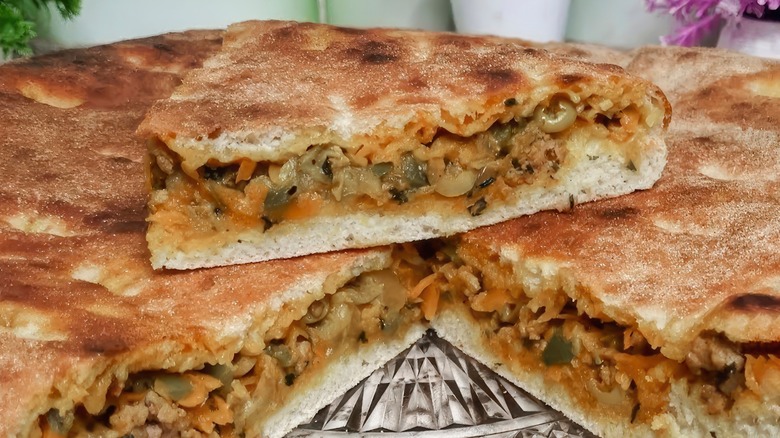The Mushroom Pizza That Earned Gordon Ramsay's Seal Of Approval
Gordon Ramsay might just be the most famous chef in the world, and it's because he's always down for a challenge. In his National Geographic show, "Gordon Ramsay: Uncharted," he explores food cultures from around the globe to learn about dishes that might be neglected by mainstream food scenes in the U.S. and England. He's gone off the beaten path (quite literally) a number of times, whether in a boat, helicopter, or Jeep. One adventure left him stunned with a delicious mushroom pizza, and no, it wasn't in Italy.
Ramsay hiked up the mountains of Morocco to learn how to make medfouna, a traditional pizza dish with the locals. Medfouna has the shape of a traditional pizza, but it has two crusts — one on the top and on the bottom — sandwiching the ingredients. For the crust-haters out there, this isn't a standard crust either, it's an underrated flatbread dish with a warm, soft mouthfeel. Upon trying medfouna, Ramsay said, "That was one of the best pizzas I've ever eaten."
Medfouna's ingredients surprised Gordon Ramsay
Gordon Ramsay's medfouna was a perfect storm of the right ingredients and environment. In the forest, his group cooked over an open flame of olive branches to heat the pan and lid from both ends, similar to using a traditional tagine. The recipe he learned contained wild morel and trumpet mushrooms, onion, garlic, and goat cheese. All were seasoned with ras el hanout, a spice blend often made with cumin, nutmeg, cardamom, ginger, and pepper on the roster. These wonderful Mediterranean ingredients worked in harmony to create an umami, savory bite for the chef.
The luxurious morel mushrooms are hand-foraged and tough to cultivate, so they're not mass-produced like other crops. Ramsay was able to gather them because he was with expert mushroom foragers, as a common mushroom mistake is confusing the tasty morel for one of its poisonous doppelgängers. He commented that he'd have to charge over £100 (over $127) to serve this kind of medfouna at his London restaurant. The morels his group gathered were delicacies in the U.S., but an everyday treat to the nomadic Amazigh (Berbers). He said, "The shock for me is that, for the boys, it's a staple. They eat it every day."

